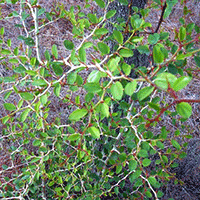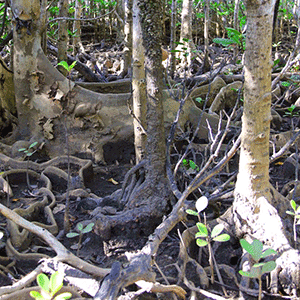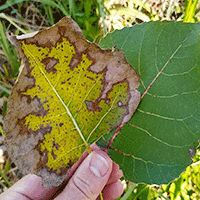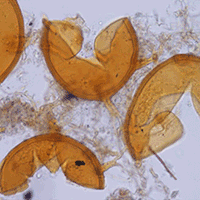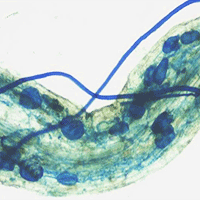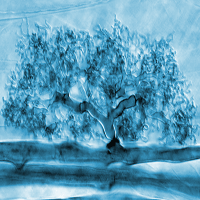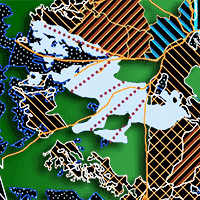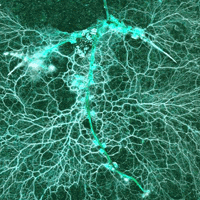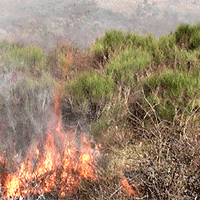Vast area of the land around the world is saline. Knowledge of plant behavior and their interaction with mychorrizal fungi in saline areas may help seedling establishment in such environments. This study aimed to determine the effects of the inoculation of the fungus Funneliformis mosseae (FM) on Ziziphus spina-christi (Rhamnaceae) plants grown under salt stress. Mycorrhizal and non-mycorrhizal seedlings were exposed to different levels of NaCl in the soil (0, 50, 100, and 150 mM). The following parameters were measured in both inoculated and non-inoculated plants: root colonization rate, seedling height, root diameter, root and shoot dry weights, chlorophyll a and b, total nitrogen (N), phosphorus (P), potassium (K) and sodium (Na+) content, proline accumulation in roots and leaves, superoxide dismutase (SOD), peroxidase (POD) and catalase (CAT) activities. The results showed that soil salinity hampered the root colonization by the fungus, and decreased basal diameter, seedling height, root and shoot dry weights, as well as some nutrients and chlorophyll a concentration, while increased leaves and roots Na+, SOD and POD activity, proline accumulation, as well as CAT activity in the roots. Contrastingly, no significant effect of soil salinity were detected on K and CAT of leaves, root N, and chlorophyll b. Inoculated plants had higher basal diameter, leaves and roots P, root and shoot dry weights, chlorophyll a and lower SOD content, proline accumulation in leaves and Na+, as compared with non-inoculated plants. Seedling height, root N, CAT and POD content, and chlorophyll b were not affected by inoculation with FM. These results demonstrated that FM inoculation is a promising method for improving the growth of Z. spina-christi seedlings under salt stress.
Keywords
, , , ,
Citation
Mirzaei J, Mirzaei Y, Naji HR (2015). Effect of Funneliformis mosseae on growth, mineral nutrition, biochemical indexes and chlorophyll content of Ziziphus spina-christi seedlings at different salinities. iForest 9: 503-508. - doi: 10.3832/ifor1643-008
Academic Editor
Silvano Fares
Paper history
Received: Mar 11, 2015
Accepted: Jul 21, 2015
First online: Dec 08, 2015
Publication Date: Jun 01, 2016
Publication Time: 4.67 months
© SISEF - The Italian Society of Silviculture and Forest Ecology 2015
Open Access
This article is distributed under the terms of the Creative Commons Attribution-Non Commercial 4.0 International (https://creativecommons.org/licenses/by-nc/4.0/), which permits unrestricted use, distribution, and reproduction in any medium, provided you give appropriate credit to the original author(s) and the source, provide a link to the Creative Commons license, and indicate if changes were made.

Breakdown by View Type
(Waiting for server response...)
Article Usage
Total Article Views: 49621
(from publication date up to now)
Breakdown by View Type
HTML Page Views: 41266
Abstract Page Views: 3016
PDF Downloads: 4106
Citation/Reference Downloads: 32
XML Downloads: 1201
Web Metrics
Days since publication: 3667
Overall contacts: 49621
Avg. contacts per week: 94.72
Article Citations
Article citations are based on data periodically collected from the Clarivate Web of Science web site
(last update: Mar 2025)
Total number of cites (since 2016): 4
Average cites per year: 0.40
Publication Metrics
by Dimensions ©
Articles citing this article
List of the papers citing this article based on CrossRef Cited-by.
(1)
Abdel Latef AA (2013)Growth and some physiological activities of pepper (
Capsicum annuum L.) in response to cadmium stress and mycorrhizal symbiosis. Journal of Agricultural Science and Technology 15: 1437-1448.
Online |
Gscholar
(2)
Abdel Latef AA, Miransari M (2014)The role of arbuscular mycorrhizal fungi in alleviation of salt stress. Use of microbes for the alleviation of soil stresses. Springer Science+Business Media, New York, USA, pp. 23-38.
CrossRef |
Gscholar
(3)
Adiku G, Renger M, Wessolek G, Facklam M, Hech-Bischoltz C (2001)Simulation of dry matter production and seed yield of common beans under varying soil water and salinity conditions. Agricultural Water Management 47: 55-68.
CrossRef |
Gscholar
(4)
Al-Karaki GN (2006)Nursery inoculation of tomato with arbuscular mycorrhizal fungi and subsequent performance under irrigation with saline water. Scientia Horticulture 109: 1-7.
CrossRef |
Gscholar
(5)
Al-Khaliel AS (2010)Effect of salinity stress on mycorrhizal association and growth response of peanut infected by
Glomus mosseae. Plant, Soil and Environment 56: 318-324.
Online |
Gscholar
(6)
Asghari HR, Marschner P, Smith SE, Smith FA (2005)Growth response of
Atriplex nummularia to inoculation with arbuscular mycorrhizal fungi at different salinity levels. Plant and Soil 273: 245-256.
CrossRef |
Gscholar
(7)
Bates LS, Waldern RP, Teave ID (1973)Rapid determination of free proline for water stress studies. Plant and Soil 39: 205-207.
CrossRef |
Gscholar
(8)
Beltrano J, Ruscitti M, Arango MC, Ronco M (2013)Effects of arbuscular mycorrhiza inoculation on plant growth, biological and physiological parameters and mineral nutrition in pepper grown under different salinity and P levels. Journal of Soil Science and Plant Nutrition 13 (1): 123-141.
Online |
Gscholar
(9)
Bisen PS, Dev A, Gour RK, Jain RK, Sengupta LK (1995)Study of vesicular-arbuscular mycorrhiza fungus
Glomus mosseae in soil samples of Bhopal. In: Proceedings of the “3
rd National Conference of Mycorrhiza”. New Delhi (India), pp. 73-76.
Gscholar
(10)
Cakmak I, Horst W (1991)Effect of aluminium on lipid peroxidation, superoxide dismutase, catalase and peroxidase activities in root tip of soybean (
Glycine max). Plant Physiology 83: 463-468.
CrossRef |
Gscholar
(11)
Daei G, Ardekani MR, Rejali F, Teimuri S, Miransari M (2009)Alleviation of salinity stress on wheat yield, yield components, and nutrient uptake using arbuscular mycorrhizal fungi under field conditions. Journal of Plant Physiology 166: 617-625.
CrossRef |
Gscholar
(12)
Evelin H, Giri B, Kapoor R (2012)Contribution of
Glomus intraradices inoculation to nutrient acquisition and mitigation of ionic imbalance in NaCl-stressed
Trigonella foenum-graecum. Mycorrhiza 22: 203-217.
CrossRef |
Gscholar
(13)
Evelin H, Kapoor R (2013)Arbuscular mycorrhizal symbiosis modulates antioxidant response in salt-stressed
Trigonella foenum-graecum plants. Mycorrhiza 24: 197-208.
CrossRef |
Gscholar
(14)
FAO (2007)FAO land and plant nutrition management service. FAO, Rome, Italy.
Online |
Gscholar
(15)
Gaur A, Adholeya A (2004)Prospects of arbuscular mycorrhizal fungi in phytoremediation of heavy metal contaminated soils. Current Science 86: 528-534.
Online |
Gscholar
(16)
Giannopolitis CN, Ries SK (1977)Superoxide dismutase I. Occurrence in higher plants. Plant Physiology 59: 309-331.
CrossRef |
Gscholar
(17)
Harborne JB (1998)Nitrogen compounds. In: “Phytochemical Methods: A Guide to Modern Techniques of Plant Analysis” (Harborne JB eds). Chapman and Hall, London, UK, pp. 187-234.
CrossRef |
Gscholar
(18)
Hajiboland R, Aliasgharzadeh N, Laiegh SF, Poschenrieder C (2010)Colonization with arbuscular mycorrhizal fungi improves salinity tolerance of tomato (
Solanum lycopersicum L.) plants. Plant and Soil science 331: 313-327.
CrossRef |
Gscholar
(19)
Hejiden JN, Klironomos M, Ursic P (1998)Mycorrhizal fungal diversity determines plant biodiversity, ecosystem variability and productivity. Nature 396: 69-72.
CrossRef |
Gscholar
(20)
Hildebrandt U, Regvar M, Bothe H (2007)Arbuscular mycorrhiza and heavy metal tolerance. Phytochemical 68: 139-146.
CrossRef |
Gscholar
(21)
Jacoby B (1994)Mechanisms involved in salt tolerance by plants. In: “Handbook of Plant and Crop Stress” (Pessarakli M). Marcel Dekker Inc, New York, USA, pp. 97-123.
Online |
Gscholar
(22)
Jin CW, Sun YL, Cho DH (2012)Changes in photosynthetic rate, water potential, and proline content in kenaf seedlings under salt stress. Canadian Journal of Plant Science 92: 311-319.
CrossRef |
Gscholar
(23)
Juniper S, Abbott LK (1993)Vesicular-arbuscular mycorrhizas and soil salinity. Mycorrhiza 4: 45-57.
CrossRef |
Gscholar
(24)
Kar M, Mishra D (1976)Catalase, peroxidase, and polyphenoloxidase activities during rice leaf senescence. Plant Physiology 57: 315-319.
CrossRef |
Gscholar
(25)
Lu Y, Wang G, Meng Q, Zhang W, Duan B (2014)Growth and physiological responses to arbuscular mycorrhizal fungi and salt stress in dioecious plant
Populus tomentosa. Canadian Journal of Forest Research 44: 1020-1031.
CrossRef |
Gscholar
(26)
Meloni DA, Gulotta MR, Martínez CA, Oliva MA (2004)The effects of salt stress on growth, nitrate reduction and proline and glycinebetaine accumulation in
Prosopis alba. Brazilian Journal of Plant Physiology 16: 39-46.
CrossRef |
Gscholar
(27)
Mirzaei J, Yousefzadeh H (2013)Peroxidase, superoxide dismutase and catalase activities of the
Pistacia khinjuk seedlings under drought stress. Ecopersia 1: 329-337.
Online |
Gscholar
(28)
Moyersoen B, Alexander IJ, Fitter AH (1998)Phosphorus nutrition of ectomycorrhizal and arbuscular mycorrhizal tree seedlings from a low land tropical rain forest in Korup National Park, Cameroon. Journal of Tropical Ecology 14: 47-61.
CrossRef |
Gscholar
(29)
Nelson DW, Sommers LE (1982)Total carbon, organic carbon and organic matter. In: “Methods of soil analysis” (Page AL, Miller RH, Keeney DR eds). Agronomy Monograph No. 9. American Society of Agronomy, Madison, WI, USA, pp. 539-579.
Gscholar
(30)
Okurowska P (2008)Effects of mycorrhizal colonization and fertilization on growth and photosynthesis of sweet basil under salt stress. Journal of Plant Nutrition 31: 497-513.
CrossRef |
Gscholar
(31)
Ouziad F, Hidebrandt U, Schmelzer E, Bothe H (2005)Differential gene expressions in arbuscular mycorrhizal-colonized tomato grown under heavy metal stress. Journal of Plant Physiology 162: 634-649.
CrossRef |
Gscholar
(32)
Phillips JM, Hayman DS (1970)Improved procedures for clearing roots and staining parasitic and vescicular-arbuscular mycorrhizal fungi for rapid assessment of infection. Transactions of British Mycological Society 55: 158-161.
CrossRef |
Gscholar
(33)
Porras-Soriano A, Soriano-Martín ML, Porras-Piedra A, Azcón R (2009)Arbuscular mycorrhizal fungi increased growth, nutrient uptake and tolerance to salinity in olive trees under nursery conditions. Plant Physiology 166: 1350-1359.
CrossRef |
Gscholar
(34)
Prasad K, Meghavansi MK, Ali Khan A (2011)Incidence of arbuscular mycorrhizal fungi (AMF) in tree species in arid zones of Ajmer region of Rajasthan. Mycorrhiza News 22 (4): 12-15.
Gscholar
(35)
Sanchez FJ, Manzanares M, De Andres EF, Tenorio JL, Ayerbe L (1998)Turgor maintenance, osmotic adjustment and soluble sugar and proline accumulation in 49 pea cultivars in response to water stress. Field Crops Research 59: 225-235.
CrossRef |
Gscholar
(36)
Singh SK, Sharma HC, Goswami AM, Datta SP, Singh SP (2000)In vitro growth and leaf composition of grapevine cultivars as affected by sodium chloride. Biologia Plantarum 43: 283-286.
CrossRef |
Gscholar
(37)
Tian CY, Feng G, Li XL, Zhang FS (2004)Different effects of arbuscular mycorrhizal fungal isolates from saline or non-saline soil on salinity tolerance of plants. Applied Soil Ecology 26: 143-148.
CrossRef |
Gscholar
(38)
Tuteja N (2007)Mechanisms of high salinity tolerance in plants. Methods in Enzymology 428: 419-438.
CrossRef |
Gscholar
(39)
Van Aarle IM, Olsson PA, Soderstrom B (2002)Arbuscular mycorrhizal fungi respond to the substrate pH of their extra radical mycelium by altered growth and root colonization. New Physiologist 155: 173-182.
CrossRef |
Gscholar
(40)
Wright DP, Read DJ, Scholes JD (1998)Mycorrhizal sink strength influences whole plant carbon balance of
Trifolium repens L. Plant, Cell and Environment 21: 881-891.
CrossRef |
Gscholar
(41)
Wu QS, Zou YN, Liu W, Ye XF, Zai HF, Zhao LJ (2010)Alleviation of salt stress in
Citrus seedlings inoculated with mychorriza: changes in leaf antioxidant defense systems. Plant Soil and Environment 56: 470-475.
Online |
Gscholar
(42)
Yang SJ, Zhang ZL, Xue YX, Zhang ZF, Shi SY (2014)Arbuscular mycorrhizal fungi increase salt tolerance of apple seedlings. Botanical Studies 55: 70-77.
CrossRef |
Gscholar
(43)
Yoshiba Y, Kiyosue T, Nakashima K, Yamaguchi-Shinozaki K (1997)Regulation of levels of proline as an osmolyte in plants under water stress. Plant, Cell and Physiology 38: 1095-1102.
CrossRef |
Gscholar
